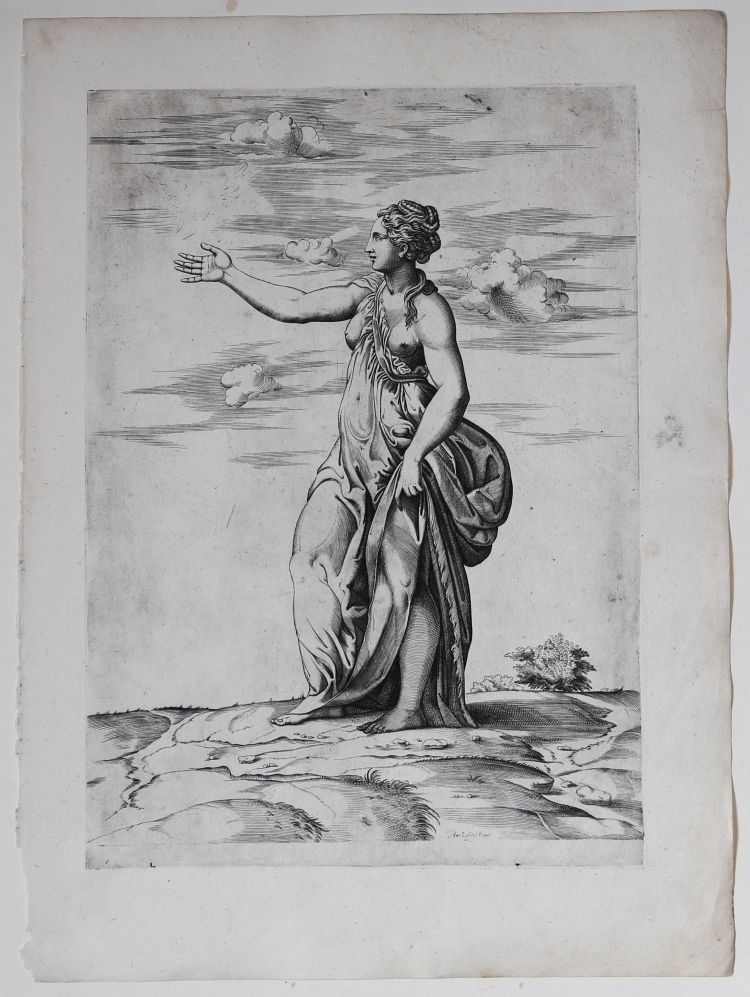





| Reference: | S48405 |
| Author | Enea VICO |
| Year: | 1550 ca. |
| Measures: | 285 x 405 mm |




| Reference: | S48405 |
| Author | Enea VICO |
| Year: | 1550 ca. |
| Measures: | 285 x 405 mm |
Engraving, ca. 1550/60, lacking signature. Editorial imprint of Antonio Lafreri at lower center.
Example the second state of three, with Lafreri’s address and cancellation of the owl but before the imprint of Giovanni Orlandi.
Replica, on the same verso, of engraving signed by Enea Vico (1548) derived from a subject by Parmigianino. Related drawings by Parmigianino are in the British Museum (Ff,1.79) and the Museum of Fine Arts, Budapest (inv. 2134).
This replica is always assigned to the hand of Enea Vico, not new to replicating - for Lafreri - subjects he had previously interpreted for the print shops of Tommaso Barlacchi and Antonio Salamanca.
Parmigianino's drawings would seem to constitute one of the ideas for the frescoes at Fontanellato, where Mazzola painted the Diana and Actaeon cycle taken from Ovid's Metamorphoses. The ceiling depicts Paola Gonzaga in the guise of Ceres in relation to the search for her daughter Proserpina kidnapped in Hades. The drawing may be an idea, later abandoned, to depict Ceres transforming Ascalafo into an owl to punish him for discovering Proserpina while she was ingesting a purple fruit breaking her fast, a condition for her exit from Hades.
Magnificent proof, rich in tone, printed on coeval laid paper with “pilgrim in the circle” watermark (Woodward nos. 3-6), with unusually wide margins, in perfect condition.
Bibliografia
Bartsch, Le Peintre graveur (XV.303.45.II).
Enea VICO (Parma 1523 - Ferrara 1567)
|
Enea, son of Francesco, was antique dealer, drawer, engraver and numismatist. He was born in Parma on January 29th, 1523, according to what Huber says. After the first school years in the city, and very likely after he made acquaintance with the works of Giulio Romano, Vico moved to Rome in 1541. He then worked for Tommaso Barlacchi, who also engraved with him a series of Grottesche, in 1542. In the classical atmosphere of Rome, Vico’s style developed according to that of Perin del Vaga and Francesco Salviati, but always with Parmigianino as main reference. Around the first half of the century and after studying the works of Marcantonio, Agostino Veneziano, Caraglio and Bonasone, Vico acquired his own, peculiar style which can be seen in his main works. From Rome Vico moved to Florence, where he worked for Cosimo I, and then went to Venice, in 1557. In 1563 he is already in Ferrara, working for Alfonso d’Este till his death in 1567.
|
Enea VICO (Parma 1523 - Ferrara 1567)
|
Enea, son of Francesco, was antique dealer, drawer, engraver and numismatist. He was born in Parma on January 29th, 1523, according to what Huber says. After the first school years in the city, and very likely after he made acquaintance with the works of Giulio Romano, Vico moved to Rome in 1541. He then worked for Tommaso Barlacchi, who also engraved with him a series of Grottesche, in 1542. In the classical atmosphere of Rome, Vico’s style developed according to that of Perin del Vaga and Francesco Salviati, but always with Parmigianino as main reference. Around the first half of the century and after studying the works of Marcantonio, Agostino Veneziano, Caraglio and Bonasone, Vico acquired his own, peculiar style which can be seen in his main works. From Rome Vico moved to Florence, where he worked for Cosimo I, and then went to Venice, in 1557. In 1563 he is already in Ferrara, working for Alfonso d’Este till his death in 1567.
|